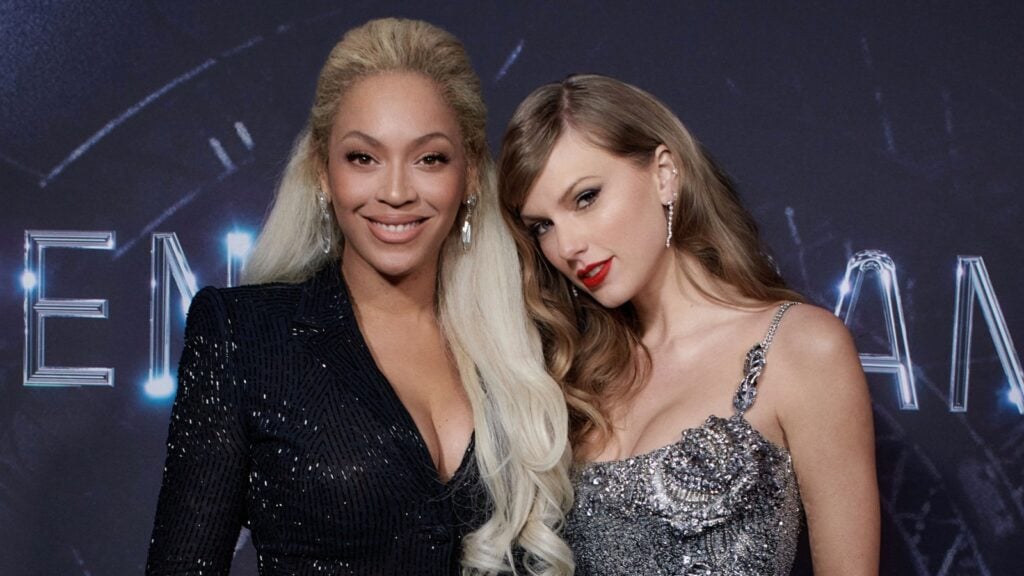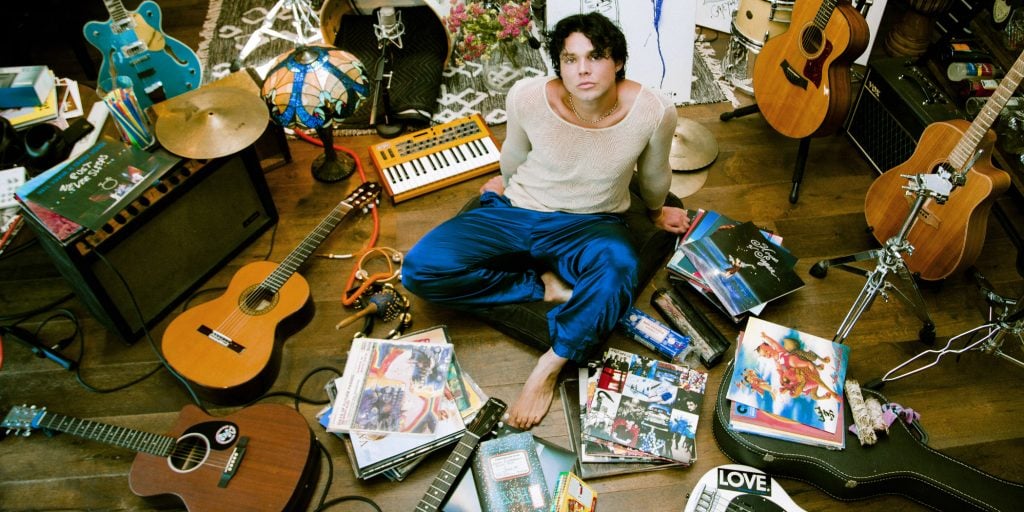Between Barbie, Taylor Swift and Beyoncé, 2023 was truly the year of female fandom. So if young female fan bases are so lucrative, why do we culturally devalue them so much?
Why is being an excited, young female fan so shameful? It’s a question many women have asked in their lifetime, particularly when it comes to their music tastes. Barely a week passes by in which we don’t see a puff piece about screaming throngs of girls dying to spot the latest boy band in the wild, or swipe past an article detailing the great lengths a fan has gone to in order to emulate, or connect with, their chosen starlet. Often this content is created in the same tone that a parent employs when they explain how their toddler will only wear his Spider-Man costume to school — with a bemused sort of affection, paired with a heady dose of patronisation.
But when we think of 2023’s Barbie movie, or Taylor Swift and Beyoncé’s mega-grossing 2023 tours, or the widespread, international obsession with K-pop, it’s hard to ignore how overwhelmingly lucrative these fan bases are. Girls are, to marketers, the most valuable fans of all — if you can capture the rapturous dedication of girl fandom, it’s basically a licence to print money. And yet, the young women who generate this staggering income for music stars and brands alike are often derided for their supposed un-seriousness or illegitimacy.
A recent Vox article, on the other hand, very seriously pondered why we deride young women when they are the original tastemakers (see: The Beatles, Elvis), essentially creating the very trends the rest of the world follow, from language to fashion and music, and everything in between. Although they didn’t arrive at a single answer, it sat somewhere between sexism, cultural conditioning, the historical mistreatment of young women and the penchant for Boomers and Gen X to elevate Gen Z personalities like Greta Thunberg as heroes, while simultaneously ignoring their calls for action.

MASON POOLE
So, why do we hate young female fandom? And why do we see it as ridiculous, hysterical and terribly unserious, despite its undeniable chokehold on pop culture, marketing, social media and company profits?
A short history of female fandom and its gendered allusion to ‘mania’ known as ‘Lisztomania’ — no, not the Phoenix song — was one of the first reported moments of mass hysteria in the well-chronicled history of female fandom. Hungarian composer Franz Liszt’s first ‘frenzy’ was reported in 1841, and the term was later coined in 1844 to describe the “intense levels of hysteria demonstrated by fans.”
As the story goes, “admirers of Liszt would swarm over him, fighting over his handkerchiefs and gloves. Fans would wear his portrait on brooches and cameos. Women would try to get locks of his hair, and whenever he broke a piano string, admirers would try to obtain it in order to make a bracelet.”
Love Music?
Get your daily dose of everything happening in Australian/New Zealand music and globally.
Sound familiar? Lisztomania, Beatlemania, the scenes outside any One Direction concert in years past, all culminate in one idea, one word: mania. The psychological connotation — which is certainly no accident — combines all these moments in time into one cultural phenomenon: the crazed female fan. But why is female fandom seen as a ‘mania’? Why is their passion translated as hysterics?
As Yve Blake points out in her widely-shared TED Talk, ‘For The Love of Fangirls’, we rarely accuse men — falling to their knees and weeping, or setting fire to the city during soccer riots after their team has lost — of mania. It’s perfectly normal for a man to cosplay in another man’s jersey, or paint their face in their team’s colours, but if women dress up for a Harry Styles concert, it’s reported on by the news as some kind of oddity. Is it not the same thing? A passion for what they love? The only difference I can see is that women tend to grow out of it.
While we ritually undermine the intelligence, passion and, quite frankly, the seriousness of young female fans by labelling or dismissing them, we ignore the power of teenage girls that we could instead harness. Social media has meant that this power has become amplified; no longer do they need to rely on others to make their voices heard, nor to hear each other. We’re all just along for the ride. And the viral dances.

The stats? We’re talking billions. With a ‘B’
When women commit, the money follows. In 2023, Barbie became the highest grossing film ever in Warner Bros. history, and the largest worldwide film release of 2023, grossing over US$2 billion. Earlier that year, Beyoncé’s Renaissance World Tour became the highest grossing tour by a female artist in history, pulling in $863 million. She was pipped at the post in December 2023, however, as Taylor Swift’s ‘Eras Tour’ officially became the highest grossing music tour ever, becoming the first to surpass US$1 billion in revenue. The film of the same name has also become the highest-grossing US concert film ever, bringing in a global haul of around US$373 million to date.
And it’s not just music. Kylie Cosmetics propelled Kylie Jenner to almost-billionaire status by the time she turned twenty-one years old, almost entirely through activating her highly-engaged social media fanbase. Her sister Kim used the same blueprint to build SKIMS, which pulled in a valuation of $5.9 billion in July 2023.
Taylor Swift has even given rise to her own marketing term — the ‘Taylor bump’ — after the NFL found Taylor Swift’s whirlwind romance with Travis Kelce had delivered one of Kelce’s games a sixty-three per cent jump in viewership among women aged eighteen to forty-nine. Add a four hundred per cent jump in sales for Kelce’s #87 jersey, and you’re starting to see the lucrative effects of a young female fanbase on almost any product, in any market. It was likely a surprise to the league, whose previous attempts to pink-package their sport with literal pink jerseys and bedazzled apparel (ugh) had fallen on deaf ears.
So why does the entertainment industry hate female fandom?
The Noughties and 2010s were overwhelmingly a time for male-heavy voices to tell us what was good — and the things that were cool, or highbrow, were certainly not the things that teenage girls liked. Online music tastemakers Pitchfork routinely excluded reviews of albums at the top of the charts due to a perceived unseriousness of pop music. At the same time, the Warped Tour was welcoming a fifty-three per cent female crowd to their alt-rock festival in 2014 as they were routinely booking almost exclusively male lineups.
As the perception of women as ‘unserious’ fans of popular culture continued, we also saw the rise of a new kind of male pop star — one that embraced fluid sexuality, and courted female fans while rejecting traditional notions of masculinity. One of these pop stars was, of course, Harry Styles, who had this to say about the historical derision of female fans to Rolling Stone in 2017: “Who’s to say that young girls who like pop music — short for popular, right? — have worse musical taste than a thirty-year-old hipster guy? That’s not up to you to say. Music is something that’s always changing. There’s no goal posts. Young girls like The Beatles. You gonna tell me they’re not serious?”
Ashton Irwin, drummer for Sydney pop rockers 5 Seconds of Summer, is also keenly aware of how young girls have their finger firmly on the pulse of what’s popular long before most.
“The young, female fanbases know what’s good before anybody else, they always have,” he told Rolling Stone AU/NZ in 2022. “They make it easy for these awful people who take advantage of that,” he continues. “Because they [the fans] all point at this great thing and go, ‘That’s the good thing.’ In a pure way. ‘We like these guys.’”

Ashton Irwin
But if you thought the days of devaluing the teen girl’s market dominance was dead in the water since the TikTok revolution, see: Matt Rife. Compared to Styles, he took a somewhat different approach to amassing a huge, young, mostly female audience that brought him TikTok fame, lucrative sponsorships, and even a Netflix stand-up comedy special. Instead of embracing the wisdom of watermelon-loving Styles, Rife decided to use his now-derided 2023 Netflix special Natural Selection to alienate his female fanbase with a series of sexist clunkers, including a domestic violence joke that saw him bordering on cancelled. Turns out we still devalue young female voices, even when they’re the only reason we’re famous, or rich, or influential.
Sure, marketers and record companies might see the looming dollar signs more clearly in the teenage fangirl these days, and trend forecasters might be more aware of their endless spring of inspiration just waiting to be tapped, but in the end, where is their power? When Greta Thunberg told the Swedish government to reduce carbon emissions in accordance with the Paris Agreement after Sweden’s hottest summer in 262 years, why didn’t they listen?
Besides driving a song to the top of the trending charts on TikTok, what power do we actually imbue in the female, teenage voice? To answer that, we have to go back to my original question — the one at the beginning of this article — because I promised you an answer.
Female fandom is undeniably powerful. The driving forces behind it combine the potent sparkle of millions of teenage girls, flush with increasing buying power, heady, unbridled emotional energy and lots of free time on their hands. So what would happen if we took young female fandom seriously? Report on it in Forbes like we do the stock market?
To give young women such power is to piss on the patriarchal systems that society — and, indeed modern capitalism — thrive upon. It would, without hyperbole or irony, upend the top end of town. And at the same time, it would disallow the tired, old advertising ploy of shilling products through driving women’s insecurity. For if women were to understand their market power, how would we control them through product messaging that tells them they’re too fat, too old, or too ugly to be important? How would we personify feminine power in an $84 face cream if they knew their power came from their passion, their emotion — or their uncanny ability to mobilise a trend in every school across the country before even the most seasoned marketers have spotted it on TikTok?
To quote writer Heinrich Heine, from his 1844 letter which originally coined the term ‘Lisztomania’: “Perhaps the solution of the question is not buried in such adventurous depths, but floats on a very prosaic surface.”
Yes, perhaps it’s really just as simple as Beyoncé herself told us. Who run the world? Girls.
This article features in the March-May 2024 issue of Rolling Stone AU/NZ. If you’re eager to get your hands on it, then now is the time to sign up for a subscription.
Whether you’re a fan of music, you’re a supporter of the local music scene, or you enjoy the thrill of print and long form journalism, then Rolling Stone AU/NZ is exactly what you need. Click the link below for more information regarding a magazine subscription.



































